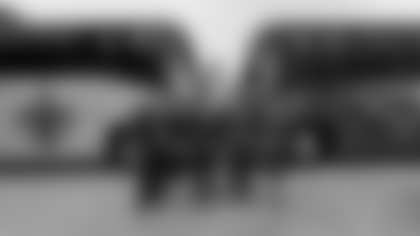Todd Graffagnini, the radio play-by-play announcer for the New Orleans Pelicans, is a walker. You can find Graff pounding the pavement somewhere around this great city almost every day. During this pause in games we've asked the New Orleans native to let fans tag along and learn about the routes he takes and some of the city's sports history.
Greetings fellow walkers. I hope you are all continuing to stay safe and practice social distancing. Now it's time to take advantage of the great weather we've been having and get outside and get a nice walk (or run) in. This time our excursion will take us to the West Bank of New Orleans and the historic neighborhood of Algiers Point.

If you're wondering where Algiers Point is, it's basically where the Mississippi River ends the "crescent" around the city and makes a sharp turn due east. Not only will you enjoy walking through this quiet and beautiful neighborhood, but also you'll be treated to the best view of the city of New Orleans, hands down. So let's get going. As always, feel free to break off this route and start one of your own, but this should be a decent starting point.
I started this walk at the corner of Verret and Alix streets in front of the Holy Name of Mary Catholic Church. Head south down Verret toward the Crescent City Connection, which will come into view in a couple of blocks. Eventually, you'll come to Opelousas Avenue, the southern boundary of the neighborhood. Take a left onto Opelousas and enjoy the oak tree-lined view. I couldn't help but think how much this street reminded me of Esplanade Avenue, which of course, we traversed a week ago. Continue on Opelousas for about six blocks till you come to Atlantic Avenue. Hang another left and head toward the levee, which will be in view the entire way.
Walking up Atlantic took me back to playing baseball not very far from where I was at Skelly Rupp Stadium in my teens. It also made me think of some of the athletes that called the West Bank their home. From Reggie Wayne to Patrick Surtain, to present day Deion Jones and Landon Collins who played on the same football team at Norman Playground in Algiers, there is no shortage of stars who began their careers here. Another of those is Steve Barrios, who grew up in Gretna, and prepped at West Jefferson. Steve was a wide receiver at Tulane University and was inducted into their Hall of Fame in 2000. A part of Tulane football broadcasts for over 30 years now, Steve recalled some of those greats beginning with a certain Baseball Hall of Famer.
"My main playground was Knights Corner or Mel Ott Park, named after THE Mel Ott, who was born in Gretna, moved on to a fabulous pro career, inducted into the Baseball Hall of Fame in 1951," Barrios said. "If you look up his stats, it's really just incredible. Hit over 500 home runs and had a .304 lifetime batting average. So he's kind of, I think, the most famous person from the West Bank, even though in latter days a lot of guys have come from there that are really big names.
"Other guys that have come after me but guys that I really admired coming from the West Bank, one of them being Kordell Stewart, who went to John Ehret High School. He had a fabulous high school career even though he didn't play ball until his junior year. Then he went to the University of Colorado, had a great career there, then drafted by the Pittsburgh Steelers where he became known as "The Slash." The first quarterback/wide receiver/running back, he gave fantasy football players fits because they didn't know if he was playing or what position he'd be."
Steve also gave an interesting take on how prep athletics and the talent has really blossomed in the last few decades.
"When I came up there were only two high schools on the West Bank, that was West Jefferson and Berhman. All the smaller high schools had morphed into junior highs, and the junior highs morphed into West Jefferson, so that made West Jeff a powerhouse...but now the West Bank is just flooded with high schools. You have John Ehret, Edna Karr, O.P. Walker, Helen Cox. All of these schools they compete now and do quite well, so the athletic landscape has really changed tremendously. The West Bank still puts out a great number of high school athletes not only recruited locally but kids wind up going other places. It's simply because there's such a great crop of high school kids coming out on the West Bank every year."
When you get to the levee, you will have gone one mile. Now comes the best part. Take a quick right on Patterson Road and go about 50 yards to the paved entrance to the top of the levee (unless of course you want to run up it through the grass). The top is two lanes and paved the entire way. You have the option to go east or west, but, trust me, on your first time you'll want to head west toward the skyline of New Orleans. You'll be able to see St. Louis Cathedral directly in front of you with the river on your right. It's also interesting to hear the very high river lapping at the concrete levee just a few feet below.

From now through the end, just enjoy the view of the city, which you can almost reach out and touch. You'll come up on Algiers Point itself, then, as you veer south again, the Algiers Point Terminal, where you can take a ferry to the East Bank. Pass the Terminal, and you're greeted by a large statue of Louis Armstrong and the beginning of the Robert E. Nims Jazz Walk of Fame. Highlighted by French Quarter-style lamp posts and ample paving, the Walk honors great jazz musicians of yesteryear, apropos considering Algiers is the birthplace of Jazz. Continue heading this way toward the CCC.

The levee is paved so you can walk as far as you want to, but for distance sake I continued until I reached the bridge, then turned back around, with the river now on the left. This time when you reach the Terminal, veer to the right and head to street level parallel with the levee, which is Morgan Street. In a couple of hundred feet you'll pass a historic landmark for the second time, the Algiers Courthouse.

Homestretch time. Morgan Street becomes Patterson Road and you'll be going against traffic so head to the sidewalk. Head east a few more blocks till you see the sign for Verrett. Take a right and head back down Verrett till the original starting point at the Church. You're done!
Hope you all enjoyed this one as much as I did. As I mentioned with the Mid-City walk, the best compliment I can give it is that I'll do it again, very soon. You will certainly want to head back to enjoy those levee views that are second to none. If you want to just walk the levee for however many miles, you can do that too. We'll talk again soon. Stay safe everyone.














